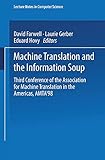Machine Translation and the Information Soup [electronic resource] : Third Conference of the Association for Machine Translation in the Americas, AMTA’98, Langhorne, PA, USA, October 28–31, 1998 Proceedings /
Material type: TextSeries: Lecture Notes in Artificial Intelligence ; 1529Publisher: Berlin, Heidelberg : Springer Berlin Heidelberg : Imprint: Springer, 1998Edition: 1st ed. 1998Description: XIX, 532 p. 38 illus., 11 illus. in color. online resourceContent type:
TextSeries: Lecture Notes in Artificial Intelligence ; 1529Publisher: Berlin, Heidelberg : Springer Berlin Heidelberg : Imprint: Springer, 1998Edition: 1st ed. 1998Description: XIX, 532 p. 38 illus., 11 illus. in color. online resourceContent type: - text
- computer
- online resource
- 9783540494782
- 006.3 23
- Q334-342
- TA347.A78
Technical Papers -- A Statistical View on Bilingual Lexicon Extraction: From Parallel Corpora to Non-Parallel Corpora -- Empirical Methods for MT Lexicon Development -- A Modular Approach to Spoken Language Translation for Large Domains -- Enhancing Automatic Acquisition of Thematic Structure in a Large-Scale Lexicon for Mandarin Chinese -- Ordering Translation Templates by Assigning Conifdence Factors -- Quality and Robustness in MT - A Balancing Act -- Parallel Strands: A Preliminary Investigation into Mining the Web for Bilingual Text -- An English-to-Turkish Interlingual MT System -- Rapid Prototyping of Domain-Specific Machine Translation Systems -- Time-Constrained Machine Translation -- An Evaluation of the Multi-engine MT Architecture -- An Ontology-Based Approach to Parsing Turkish Sentences -- Monolingual Translator Workstation -- Fast Document Translation for Cross-Language Information Retrieval -- Machine Translation in Context -- EasyEnglish: Addressing Structural Ambiguity -- Multiple-Subject Constructions in the Multilingual MT-System CAT2 -- A Multilingual Procedure for Dictionary-Based Sentence Alignment -- Taxonomy and Lexical Semantics - from the Perspective of Machine Readable Dictionary -- Can Simultaneous Interpretation Help Machine Translation? -- Sentence Analysis Using a Concept Lattice -- Evaluating Language Technologies: The MULTIDOC Approach to Taming the Knowledge Soup -- Integrating Query Translation and Document Translation in a Cross-Language Information Retrieval System -- When Stålhandske Becomes Steelglove -- SYSTRAN on AltaVista A User Study on Real-Time Machine Translation on the Internet -- Making Semantic Interpretation Parser-Independent -- Implementing MT in the Greek Public Sector: A Users’ Survey -- Statistical Approach for Korean Analysis: a MethodBased on Structural Patterns -- Twisted Pair Grammar: Support for Rapid Development of Machine Translation for Low Density Languages -- A Thematic Hierarchy for Efficient Generation from Lexical-Conceptual Structure -- The LMT Transformational System -- Finding the Right Words: An Analysis of Not-Translated Words in Machine Translation -- Predicting What MT Is Good for: User Judgments and Task Performance -- Reusing Translated Terms to Expand a Multilingual Thesaurus -- Spicing Up the Information Soup: Machine Translation and the Internet -- Revision of Morphological Analysis Errors Through the Person Name Construction Model -- Lexical Choice and Syntactic Generation in a Transfer System Transformations in the New LMT English-German System -- Translation with Finite-State Devices -- Lexical Selection for Cross-Language Applications: Combining LCS with WordNet -- Improving Translation Quality by Manipulating Sentence Length -- Machine Translation among Languages with Transitivity Divergences Using the Causal Relation in the Interlingual Lexicon -- A Comparative Study of Query and Document Translation for Cross-Language Information Retrieval -- Lexicons as Gold: Mining, Embellishment, and Reuse -- System Descriptions -- System Description/Demo of Alis Translation Solutions Overview -- System Demonstration SYSTRAN® Enterprise -- Integrating Tools with the Translation Process -- EMIS A Multilingual Information System -- An Open Transfer Translation -- TransEasy: A Chinese-English Machine Translation System Based on Hybrid Approach -- Sakhr Arabic-English Computer-Aided Translation System -- System Description/Demo of Alis Translation Solutions Application: Multilingual Search and Query Expansion -- Logos8 System Description.
Machine Translation and the Information Soup! Over the past fty years, machine translation has grown from a tantalizing dream to a respectable and stable scienti c-linguistic enterprise, with users, c- mercial systems, university research, and government participation. But until very recently, MT has been performed as a relatively distinct operation, so- what isolated from other text processing. Today, this situation is changing rapidly. The explosive growth of the Web has brought multilingual text into the reach of nearly everyone with a computer. We live in a soup of information, an increasingly multilingual bouillabaisse. And to partake of this soup, we can use MT systems together with more and more tools and language processing technologies/information retrieval engines, - tomated text summarizers, and multimodal and multilingual displays. Though some of them may still be rather experimental, and though they may not quite t together well yet, it is clear that the future will o er text manipulation systems that contain all these functions, seamlessly interconnected in various ways.


There are no comments on this title.